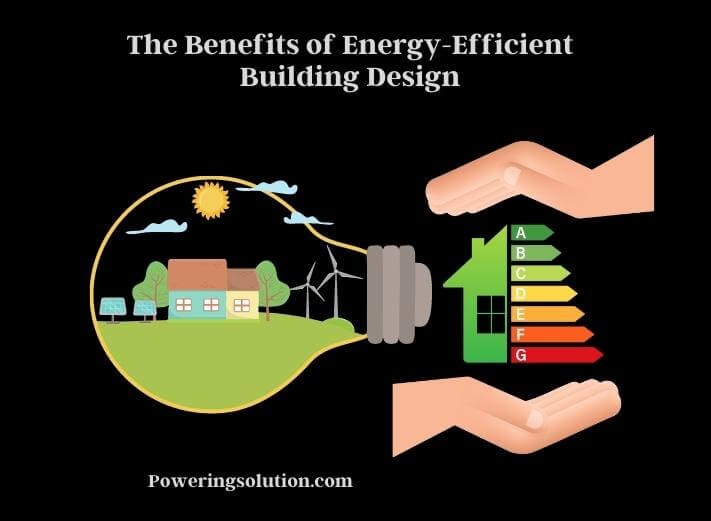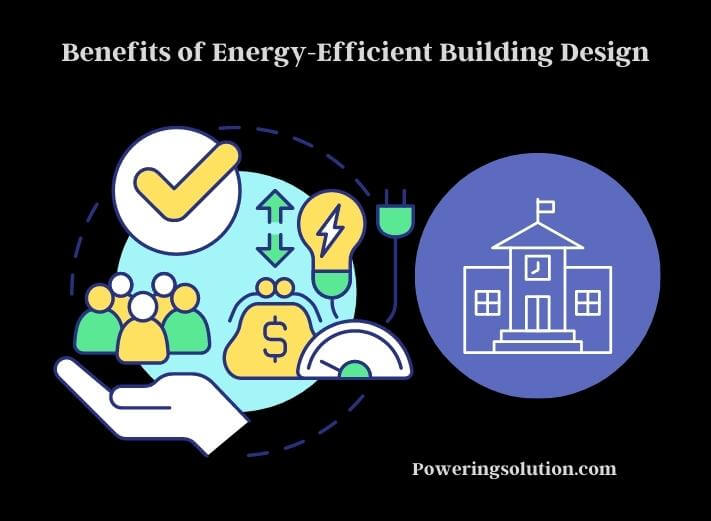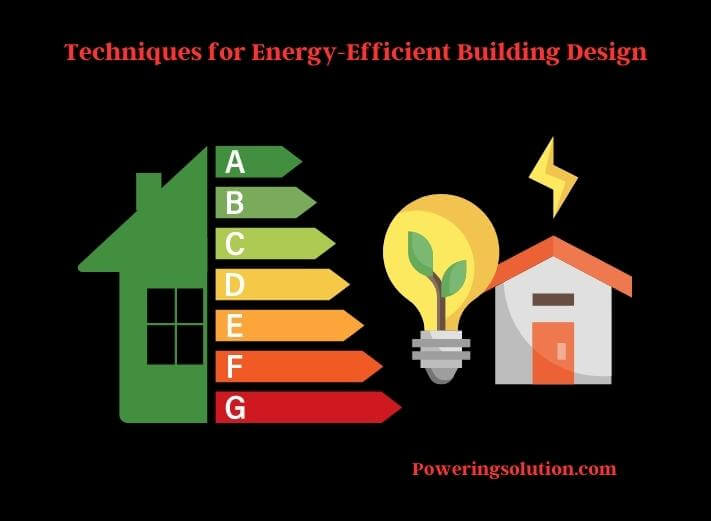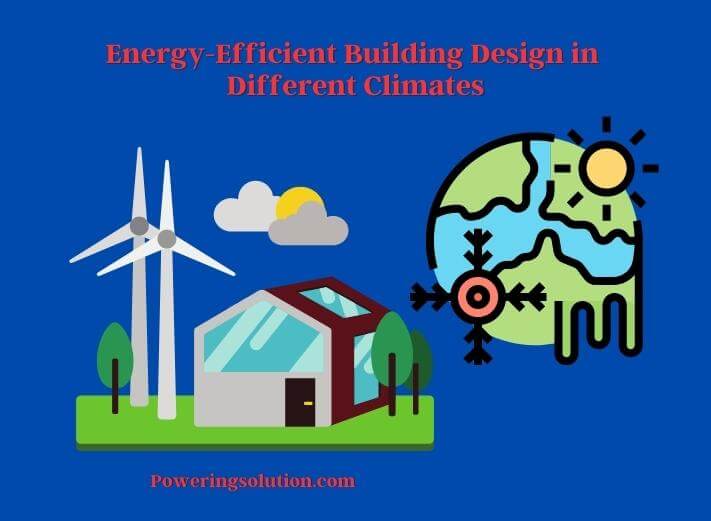The energy-efficient building design has become an increasingly popular topic in recent years, and for good reason. With rising energy costs and growing concerns about the environment, more and more people are looking for ways to reduce their energy consumption and lower their carbon footprint. Energy-efficient building design offers a way to achieve both of these goals while also providing numerous other benefits.

By following techniques like insulation, efficient heating and cooling systems, and renewable energy sources, builders can create buildings that are not only energy-efficient but also cost-effective and environmentally friendly. These buildings can help reduce energy consumption, lower monthly utility bills, and reduce greenhouse gas emissions, all while providing a comfortable living or working space for occupants.
The energy-efficient building design is also becoming increasingly important from a societal standpoint. As more and more people become aware of the importance of sustainability and reducing their environmental impact, energy-efficient buildings are becoming a more popular choice for homeowners and commercial property investors.
Benefits of Energy-Efficient Building Design
Lower Energy Bills
One of the most significant benefits of energy-efficient building design is the potential for lower energy bills. Using less energy, homeowners and building owners can save money on their monthly energy bills. This is especially important in areas with high energy costs, where savings can quickly add up.
Reduced Environmental Impact
Energy-efficient buildings also have a lower environmental impact than traditional buildings. Using less energy, these buildings produce fewer greenhouse gas emissions, which contribute to climate change. Energy-efficient buildings can reduce the demand for non-renewable energy sources, such as coal and natural gas.

Improved Comfort
Energy-efficient building design can also improve the comfort of the building’s occupants. By using efficient heating and cooling systems, these buildings can maintain a more consistent temperature throughout the year, which can be especially beneficial in extreme climates.
Increased Property Value
Energy-efficient buildings are becoming increasingly popular among homebuyers and commercial property investors. As a result, these buildings can have a higher property value than traditional buildings, making them a smart investment for building owners.
Techniques for Energy-Efficient Building Design
Insulation
One of the most critical techniques for energy-efficient building design is proper insulation. Using high-quality insulation materials, builders can help prevent heat loss in the winter and heat gain in the summer, reducing the need for heating and cooling systems.
Efficient Heating and Cooling Systems
Another key technique for energy-efficient building design is using efficient heating and cooling systems. This can include using high-efficiency HVAC systems, smart thermostats, and programmable thermostats.

Renewable Energy Sources
Renewable energy sources can also be used to make buildings more energy-efficient. This can include installing solar panels, wind turbines, and geothermal heating and cooling systems.
Energy Codes and Standards
One important aspect of energy-efficient building design is compliance with energy codes and standards. These codes and standards provide guidelines and requirements for building design and construction to ensure that buildings meet certain energy efficiency criteria.
Energy codes and standards can vary depending on location, but they typically include requirements for building insulation, efficient heating and cooling systems, lighting, and ventilation. Some codes and standards also include requirements for renewable energy sources, such as solar panels or wind turbines.
Compliance with energy codes and standards can have numerous benefits for building owners and occupants. For example, buildings that meet these requirements are typically more energy-efficient, which can result in lower monthly utility bills for occupants. Additionally, energy-efficient buildings may be more comfortable to live or work in, with more consistent temperatures and better indoor air quality.
Compliance with energy codes and standards is also important from an environmental perspective. To reduce energy consumption, these buildings can help lower greenhouse gas emissions and promote a more sustainable future. Furthermore, compliance with energy codes and standards may be required by law in certain areas, making it necessary for builders and property owners to prioritize energy efficiency in their designs.
Case Studies of Energy-Efficient Building Design
There are many examples of successful energy-efficient building designs that have been implemented around the world.
The Bullitt Center in Seattle, Washington, USA
This six-story office building was designed to be one of the greenest commercial buildings in the world, with features such as a rooftop solar array, rainwater harvesting, and a composting system. The building is also designed to use 82% less energy than a typical commercial building, resulting in lower energy costs for tenants.
The Edge in Amsterdam, Netherlands
This innovative office building is designed to be one of the most sustainable and energy-efficient buildings in the world. The building uses smart sensors and advanced technology to optimize energy use and create a comfortable working environment for occupants. It also includes features such as solar panels, a green roof, and a rainwater harvesting system.
The Pearl in San Antonio, Texas, USA
This mixed-use development is designed to be one of the most energy-efficient buildings in the United States, with features such as high-performance windows, a green roof, and a rainwater harvesting system. The building is also designed to use 65% less energy than a typical building of its size, resulting in lower energy costs for tenants.
The Green Lighthouse in Copenhagen, Denmark
This student center at the University of Copenhagen is designed to be a model of sustainable and energy-efficient building design. The building includes features such as a solar thermal system, a green roof, and a rainwater harvesting system. It is also designed to use 60% less energy than a typical building of its size.
These case studies demonstrate that energy-efficient building design is not only possible but also highly effective in reducing energy consumption and promoting sustainability. With implementing features like solar panels, green roofs, and rainwater harvesting systems, builders can create buildings that are not only environmentally friendly but also cost-effective and comfortable for occupants.
Energy-Efficient Building Design in Different Climates
Energy-efficient building design can vary depending on the climate and location of the building. Here are some examples of how energy-efficient building design can be adapted to different climates:

| Hot and humid climates | It is important to focus on reducing heat gain and improving ventilation to keep buildings cool. Some strategies for achieving this include using light-colored, reflective roofing materials, shading windows with overhangs or awnings, and incorporating natural ventilation systems, such as ceiling fans or operable windows. |
| Cold climates | It is important to focus on reducing heat loss and improving insulation to keep buildings warm. Some strategies for achieving this include using high-performance windows with low U-values, insulating walls and roofs to high R-values, and incorporating air sealing and weatherization measures to prevent drafts. |
| Temperate climates | It is important to focus on designing buildings that can adapt to changing weather conditions. Some strategies for achieving this include using operable windows to allow for natural ventilation when the weather is mild, incorporating shading devices to reduce heat gain in the summer, and using thermal mass to store heat in the winter. |
| Mixed climates | It is important to design buildings that can perform well in a variety of weather conditions. Some strategies for achieving this include using high-performance windows and insulation to reduce heat loss and gain, incorporating natural ventilation systems for cooling, and using shading devices to prevent overheating in the summer. |
Challenges and Solutions in Energy-Efficient Building Design
While energy-efficient building design has many benefits, there are also challenges that must be addressed in the design process. One of the biggest challenges to implementing energy-efficient building design is the upfront cost. Over time, energy-efficient buildings can save money on energy bills and maintenance costs. To address this challenge, builders can consider financing options or incentives for energy-efficient building design.
Another challenge is the lack of education and awareness about energy-efficient building design among builders, designers, and occupants. To address this challenge, educational programs, and outreach efforts can be implemented to educate stakeholders about the benefits of energy-efficient building design.
Retrofitting existing buildings to make them more energy-efficient can be challenging due to the need to integrate new systems with existing ones. To address this challenge, builders can consider phased retrofits, where energy-efficient upgrades are implemented gradually over time.
Building codes and regulations can sometimes be a barrier to energy-efficient building design. To address this challenge, builders can work with policymakers and stakeholders to update codes and regulations to incentivize and promote energy-efficient building design.
Another challenge is ensuring that energy-efficient buildings perform as intended over time. To address this challenge, builders can implement performance monitoring systems that track energy use and other performance metrics to identify areas for improvement and ensure that the building continues to perform efficiently.
Energy-efficient building design requires a holistic approach that addresses both technical and non-technical challenges. Addressing these challenges and implementing solutions that prioritize energy efficiency, builders can create buildings that are not only environmentally friendly but also cost-effective and comfortable for occupants.
If you want to protect your devices with standby UPS Systems, see here to know the process.
Policies and Incentives for Energy-Efficient Building Design
Policies and incentives play a crucial role in promoting energy-efficient building design. Here are some examples of policies and incentives that governments, organizations, and communities can use to encourage energy-efficient building design:
- Building codes and regulations can set minimum energy efficiency standards for buildings, which can incentivize builders to incorporate energy-efficient design features. For example, some building codes require new buildings to meet certain energy efficiency standards or require energy-efficient upgrades for existing buildings.
- Governments can offer tax credits and rebates to builders or building owners who implement energy-efficient building design features. This can help offset the upfront costs of energy-efficient upgrades and encourage more builders to adopt these design features.
- Green building certifications, such as LEED (Leadership in Energy and Environmental Design), can provide incentives for builders to design and construct energy-efficient buildings. These certifications often require buildings to meet certain energy efficiency criteria, which can encourage builders to incorporate energy-efficient design features.
- Utilities can offer incentives, such as rebates or reduced energy rates, to building owners who implement energy-efficient upgrades. This can help offset the upfront costs of energy-efficient upgrades and encourage more building owners to adopt these design features.
- Governments, organizations, and communities can provide education and outreach programs to educate builders and building owners about the benefits of energy-efficient building design. This can help raise awareness and encourage more builders to incorporate energy-efficient design features.
The Bottom Line
Energy-efficient building design offers many benefits, including lower energy costs, reduced environmental impact, and increased comfort for occupants. However, achieving energy-efficient building design requires a holistic approach that addresses technical and non-technical challenges, including cost, education and awareness, integration with existing systems, building codes and regulations, and performance monitoring.
Policies and incentives can play a crucial role in promoting energy-efficient building design Incentivizing builders and building owners to adopt energy-efficient design features. By implementing these strategies, we can create buildings that are not only environmentally friendly but also cost-effective and comfortable for occupants. As we continue to prioritize energy efficiency in building design, we can work towards a more sustainable future for ourselves and for future generations.
